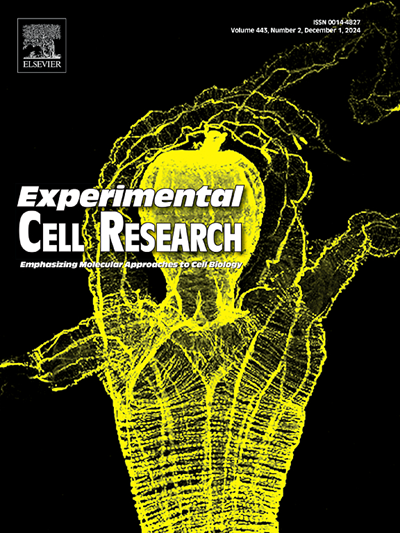III型钠依赖性无机磷酸盐转运体是人脑微血管内皮细胞表型所必需的
IF 3.3
3区 生物学
Q3 CELL BIOLOGY
引用次数: 0
摘要
脑内无机磷酸盐(Pi)稳态对原发性脑钙化(PBC)的发展至关重要。在PBC患者的大脑中,钙化发生在大脑小血管中,主要是由SLC20A2突变引起的,SLC20A2是一种编码III型Pi转运体的基因。先前的一项研究发现,SLC20家族,包括SLC20A1和SLC20A2,有助于中枢神经系统的Pi稳态。然而,这些Pi转运蛋白对脑血管表型的影响尚不清楚。因此,在本研究中,我们旨在研究SLC20A1或SLC20A2缺失对人脑微血管内皮细胞(hBMECs)表型的影响。我们评估了血管内皮细胞的主要表型,如增殖、管形成和VE-cadherin表达。结果显示,SLC20A1或SLC20A2沉默的hBMECs增殖和血管生成能力以及VE-cadherin表达均下降。slc20a1沉默的hbmec细胞内Pi浓度([Pi]i)保持不变,而slc20a2沉默的hbmec细胞内Pi浓度升高。在slc20a2沉默的hbmes中,即使在3 mM浓度高于[Pi]i的情况下,成管能力也没有变化。因此,slc20a2沉默hbmec中[Pi]i的增加可能对表型变化的影响较小。总之,SLC20A2缺失引起的Pi稳态异常在PBC内皮病理中起次要作用。本文章由计算机程序翻译,如有差异,请以英文原文为准。
Type III sodium-dependent inorganic phosphate transporters are required for the phenotypes in human brain microvascular endothelial cells
Inorganic phosphate (Pi) homeostasis in the brain is critical for the development of primary brain calcification (PBC). In the brains of patients with PBC, calcification occurs in the cerebral small vessels, and it is primarily caused by mutated SLC20A2, a gene that encodes a type III Pi transporter. A previous study founded that the SLC20 family, which includes SLC20A1 and SLC20A2, contributes to Pi homeostasis in the central nervous system. However, the impact of these Pi transporters on the brain vessel phenotype remains unknown. Thus, in this study, we aimed to investigate the effect of SLC20A1 or SLC20A2 depletion on the phenotype of human brain microvascular endothelial cells (hBMECs). We assessed the primary phenotypes of vascular endothelial cells, such as proliferation, tube formation, and VE-cadherin expression. The results showed that hBMECs silenced for SLC20A1 or SLC20A2 had decreased proliferative and angiogenic ability, as well as VE-cadherin expression. The intracellular Pi concentration ([Pi]i) remained constant in SLC20A1-silenced hBMECs whereas it increased in SLC20A2-silenced cells. Tube formation ability was no change even at 3 mM, a concentration higher than [Pi]i which was increased in SLC20A2-silenced hBMECs. Thus, increased [Pi]i in SLC20A2-silenced hBMECs may have a small impact on phenotypic changes. In conclusion, abnormalities in Pi homeostasis caused by SLC20A2 depletion were suggested to play a minor role in PBC endothelial pathology.
求助全文
通过发布文献求助,成功后即可免费获取论文全文。
去求助
来源期刊

Experimental cell research
医学-细胞生物学
CiteScore
7.20
自引率
0.00%
发文量
295
审稿时长
30 days
期刊介绍:
Our scope includes but is not limited to areas such as: Chromosome biology; Chromatin and epigenetics; DNA repair; Gene regulation; Nuclear import-export; RNA processing; Non-coding RNAs; Organelle biology; The cytoskeleton; Intracellular trafficking; Cell-cell and cell-matrix interactions; Cell motility and migration; Cell proliferation; Cellular differentiation; Signal transduction; Programmed cell death.
 求助内容:
求助内容: 应助结果提醒方式:
应助结果提醒方式:


